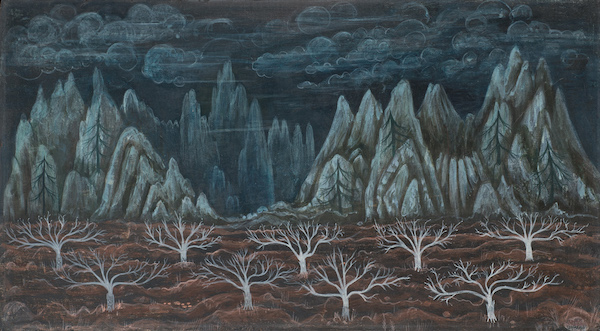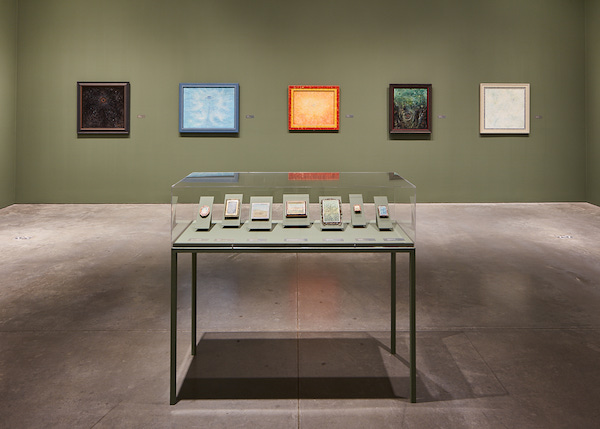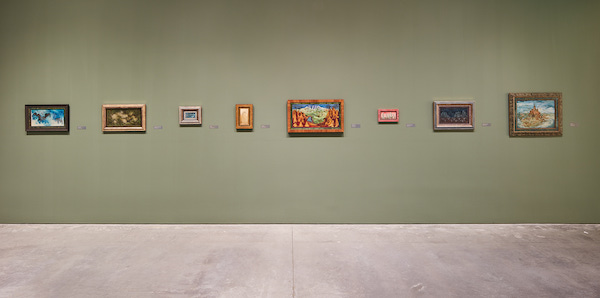Your cart is currently empty!
Sylvia Fein at Berkeley Art Museum

Sylvia Fein’s exhibition at the Berkeley Art Museum (#275 in their MATRIX series running Nov 13, 2019–March 1, 2020) gave us the rare opportunity to see the work of an artist who has forged her own path for over 75 years. The exhibition is a concise, thrilling selection which celebrates Fein’s 100th birthday, with the most recent painting dating from last year.

Fein first found her artistic identity in Wisconsin with a group of other young artists interested in the permissions of Surrealism and archaic techniques such as silverpoint and egg tempera. She committed herself to a lifelong exploration of egg tempera, and also absorbed the approach of the early Netherlandish painters, with a detailed surface grounded in careful drawing. Living in Ajijic, Mexico for two years, she produced the work for her first solo show at the Klaus Perls Gallery, in 1947. She and her husband, Bill Scheuber, subsequently moved to the San Francisco Bay Area, where they lived for a time on a houseboat, raising their daughter Heidi. For several years, Fein put painting aside to work on two books describing the role of drawing in childhood development, Heidi’s Horse (1976) and First Drawings: Genesis of Visual Thinking (1993).

My first encounter with Fein came at the revelatory show of women Surrealist painters at the Los Angeles County Museum of Art (LACMA) in 2012. One of the most captivating paintings was a 1942–43 egg tempera portrait of Fein and her husband, The Lady with the White Knight. The two vulnerable and gangly figures looked surprisingly sexy in their tattered finery. The other Fein paintings from the 1940s and ‘50s in the LACMA show featured young women with knowing smiles, inhabiting landscapes that synthesized such diverse traditions as Persian and early Italian painting.

The show at Berkeley is notable for curator Lawrence Rinder’s decision to focus on landscapes, beginning with Landscape for Cats (1946). From the start, Fein’s approach to landscape was informed by a poetic sensibility. The postcard-sized Bleached Trees (1961) creates a shivering field of ephemeral vertical forms, while in Breakers and Birds Flying into a Storm, (both 1965), she dissolves foreground and background into churning waves that foretell her later works. And with its flaming trees, The Painting Told Me What to Do (2012) has the force of a Blakean vision.

This idiosyncratic approach to landscape is amplified by Fein’s use of her chosen medium. One thinks of egg tempera as an exacting discipline that uses small opaque strokes to build solid forms. Fein’s profound understanding of the paint allows her to use it with astonishing flexibility: it can become delicately vaporous, suggestive of translucent atmospheres, while at other times she employs it in a rapid spontaneous manner, as if she were sketching with the paint. We heap praise on painters (often male) for their adventurous handling of their medium, yet Fein’s exciting re-investigation of an ancient practice has been hiding in plain sight all these years.

When she returned to making art in 2000, a single wide-open eye dominated many of the paintings: now the eye as both a kite and an ovum with several kite tails / sperm wriggling around it, now as the center of a dandelion with tiny fractured marks indicating the blossoms. The eye moves into the center of an open field in later paintings, eventually unmooring and becoming one element in the cosmos, one image amidst a sea of marks.

This seems to me when her art becomes most powerful, when the image vanishes into a galaxy or an ocean. These paintings are entrancing—the marks undulate, unfold or radiate, and the colors are luminous or swathed in shadows. The paint-strokes that previously described eyelashes or branches have now dissolved into vibrating movements. The Demons Down Under the Sea (the largest painting in the show at 40” x 30”) is a lexicon of possible brushstrokes, from precise and tender to scraping and stabbing. The freedom with which Fein has created these works in her 90s—almost half the show is from the last decade—communicates a sense of urgency. These paintings evoke the release from the quotidian into the infinite, from the prison of the individual into the ecstasy of the mystics. Bertrand Russell said: “An individual human life should be like a river: small at first, narrowly contained within its banks, and rushing passionately past rocks and waterfalls. Gradually the river grows wider, the banks recede, the waters flow more quietly, and in the end, without any visible break, they become merged in the sea, and painlessly lose their individual being.”

Fein takes us by the hand and walks us up to the edge of this precipice where our individuality vanishes and we become part of the swirling matter of cosmic dust. It is a powerful gift to us and a rare accomplishment that can only be achieved by a deeply experienced artist who has this much mastery at her command and such a clear-eyed vision of life. This small but inspiring group of paintings is just a foretaste of what a more comprehensive exhibition of Fein’s work would give us.